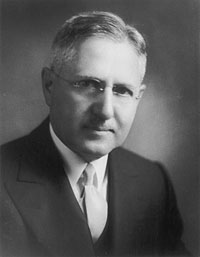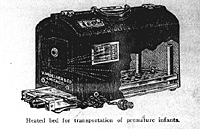
Heated Bed for Transportation of Premature
Infants
Journal [of the American Medical Association] 80(18):1313, 1923.
 |
|
This electrically heated bed is constructed to meet conditions encountered in the home and in transporting premature infants from distant points by train or automobile. It is designed as part of the obstetric department equipment for general and special hospitals or other institutions likely to be called on for the temporary care of premature infants.
The hand bag is of leather and steel construction, 19 1/2 inches long, 9 1/2 inches wide and 15 inches deep. It is divided into two compartments, the lower containing electric heating units, and the upper the crib. It is ventilated through the top by means of an adjustable slide. Observation of the infant is made possible through a glass window in the front of the bag, and a thermometer is fastened on the inside at the window in such a position that it may be easily read from without. The bag is electrically heated, the light being controlled by a push button on the end of the bag.

There are two heating units. The first is so constructed that it may be operated on any of three voltages: 110, for ordinary city lighting, 64 and 32, for railroad travel (the voltages used in train lighting). The second unit is designed for transportation by automobile, the plug being inserted into the lamp socket on the instrument board. To secure an equal distribution of heat throughout the bag, the false bottom is thoroughly perforated and a 1 inch tube is inserted at each corner of the false bottom and rises to the top of the bag. The heat thus reaches the mattress from below, and at the same time the upper part of the bag is warmed by radiation. The heating unit was designed by the Russell Electric Company.
Clothing and blankets used for dressing the infant during transportation should be made from heavy woolen materials.